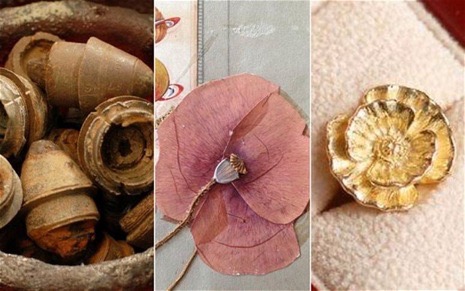From battlefield to buttonhole: the poppies made of shells
Shells fired on the Western Front are to be turned into commemorative “poppies” by the Royal British Legion to mark the centenary of the outbreak of the First World War

From left: brass fuse caps, Pte Smith's poppy and the British Legion memento
By David Williams
Almost a century after the guns fell silent on the Western Front, the shells that they fired are being returned to Britain in a remarkable act of remembrance to mark the centenary of the outbreak of the First World War.
Hundreds of brass fuse caps, which were primed to detonate on impact with enemy targets, lie scattered along the 450-mile former front line.
Now the once-deadly objects are finding a peaceful new lease of life − as commemorative “poppies”, struck by the Royal British Legion.
The conical 1lb fuses, once produced in their millions by munitions workers in Britain before being shipped to France and Belgium, are being melted down in a furnace in the Midlands at more than 1,000 degrees centigrade.
The molten metal is poured into elaborate clay moulds in a painstaking procedure known as the “lost wax” process. When the metal has cooled the moulds are broken open to reveal the crisp, ornate, golden-coloured poppies that are handcrafted into cufflinks and lapel pins.
Each one is polished, before being engraved by the Assay Office with the dates 1914-1918 and presented in velvet-lined wooden boxes with a certificate of authenticity.
The Royal British Legion will put the mementos on sale in June in time for the centenary of Britain’s declaration of war on August 4, 1914.
It hopes that many of its 350,000 members, as well as thousands of members of the public, will buy the poppies to raise money for its work supporting serving and former Servicemen and women.
“I stumbled across the idea when researching a book into historic artefacts still visible on the Somme and in Belgium,” said Christopher Bennett, who founded TMB Art Metal, a London firm which specialises in creating jewellery and works of art from the parts of cars, trains and aircraft.
TMB was formed in 2005 following the excavation of a Battle of Britain Hurricane fighter which crashed into Buckingham Palace Road in 1940. Parts of the aircraft were made into limited edition sculptures.
Brian Gray, the Royal British Legion’s Poppy Shop buyer, said: “These poppies really are special. For us they are a direct link right back to the battlefields. It feels like reaching out and touching history.
“What is most remarkable is that these objects were created for war but are now being turned into an act of remembrance that will help the Legion and its dependants. It’s turning evil into good.”
The design for the lapel pins and cufflinks, which are 1.5cm across and weigh 5g each, is based on a poppy sent back from no man’s land in 1915.
It was preserved by Private Len Smith, who kept an illustrated diary documenting his exploits during the First World War, which was published in 2009 under the title Drawing Fire.
The flower was sandwiched between the pages of the book and preserved. Pte Smith’s descendants agreed that it should be used as the basis for the Royal British Legion project, and a delicate master sculpture was handcrafted by York-based artist Stephen Allen.
All profits from the sale of the poppies will go to the Royal British Legion. Mr Bennett has agreed to recover only the costs incurred in producing the objects.
He plans to follow up the initial design with special editions marking each year of the conflict.
“Considering that they are made of 100-year-old corroded detritus that has lain undisturbed on battlefields for so long, the transformation into beautiful poppies − looking for all the world like 18ct gold − is astonishing,” said Mr Bennett. “It has been an immense privilege to produce them and to work with the Royal British Legion.”
The poppies go on sale at the beginning of June through the Royal British Legion’s website: poppyshop.org.uk